Whites & Blacks during the colonisation in the late 19th Century
This page provides an insight into the treatment of the First Nations peoples in the second phase of the mass slaughters in the Australian Eastern states and the archaic attitudes of the colonisers immediately following the first stage of the invasion and the many massacres, land theft and displacements in the late 18th to the mid 19th centuries.
This transcript covers 5 pages of volume 1 from 'The Australian Race, its origin, languages, customs, place of landing in Australia and the routes by which it spread itself over that continent' published in 1886.
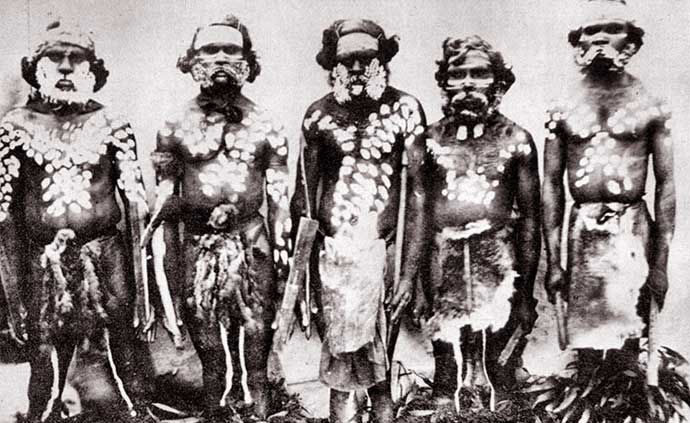
Five members of the Mount Clay Tribe, photograph by Thomas Hannay. Source: Glenelg Library Victoria
The Australian Race, its origin, languages, customs, place of landing in Australia and the routes by which it spread itself over that continent
The fight for Land
A matter of great interest in connection with our Blacks is the history of their contact with ourselves. As far as we can judge of its ultimate result from past experience, the extinction of the savage race seems inevitable, and at no distant period. The circumstances which have already led to something very like its total extinction in those portions of the continent in which our rule has prevailed for say forty years, may be generalized as follows :-
In the first place, the meeting of the Aboriginal tribes of Australia and the White pioneer, results as a rule in war which lasts from six months to ten years, according to the nature of the country, the amount of settlement which takes place in a neighbourhood, and the proclivities of the individuals concerned.
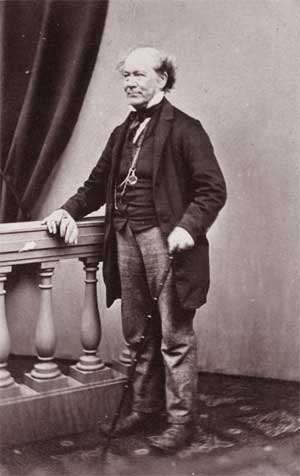
William Thomas, Protectorate, 1860,
State Library of Victoria.
Source: Aboriginal History Yarra
When several squatters settle in proximity, and the country they occupy is easy of access and without fastnesses to which the Blacks can retreat, the period of warfare is usually short and the bloodshed not excessive. On the other hand, in districts which are not easily traversed on horseback, in which the Whites are few in number and food is procurable by the Blacks in fastnesses, the term is usually prolonged and the slaughter more considerable.
In the early days of our colonization, the area taken up by a squatter was small, from twenty thousand to one hundred thousand acres being the average extent of runs. At that period, also, a great many more men were employed in the management of a given number of sheep or cattle than at present, the result of which was that the settlers and their servants were not only able to cope with the Blacks, but their numbers inspired respect, and comparatively few were shot down.
Protectorates of Natives
At that time, also, Government endeavoured, and in many cases succeeded, in affording its protection to the Blacks. After stock had increased in the colonies, flocks became larger and population more disseminated, small bodies of mounted police were enlisted from the White population, and were employed to punish outrages committed by the Blacks.
Subsequently, it became the custom to supplement the White police with a few Black troopers, who were found of great service in tracking their offending countrymen to their retreats. That they would, not merely readily, but with avidity, engage in such a service at a distance from their own country, the reader will readily understand, as he is aware that one of the leading characteristics of the Australian Black is that he entertains an intense hatred to every man and child of his own colour, outside of those tribes with which he is personally acquainted, and longs to satisfy it with blood.
Since about the year 1850, the areas of squattages, more especially in the Colony of Queensland, have enormously increased, and population being correspondingly small in that colony, an increase of mounted troopers has been found necessary.
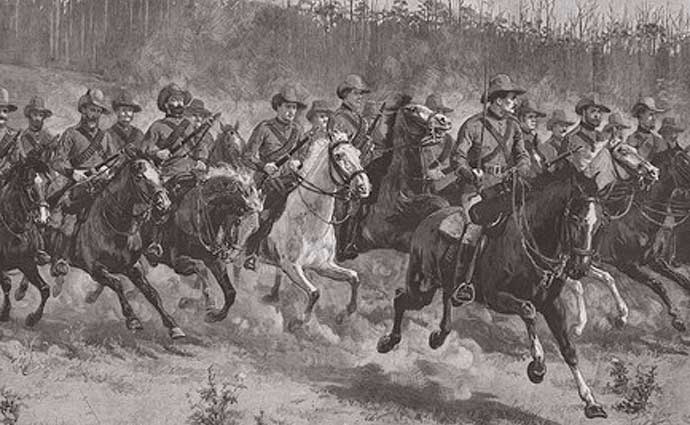
A company of the Victorian Mounted Rifles on manoeuvres in Victoria in 1889
Drawing by Frank Dudd 1890
Native Mounted Police and Killings
When cattle are speared, or have taken alarm at the sight or smell of the Blacks, and moved off, the aggrieved squatter sends for the nearest Inspector, who proceeds to the spot and accompanied by a portion of his men commences a search for Blacks. Any Black will do.
Into such enterprises his troopers enter with fiendish energy and ingenuity, and on the first Blacks encountered this English official looses his thirsty warhounds keeping at a safe distance from spears, as many males as possible are then shot down with the rifle, whether they have been offenders or not; none, if possible, are allowed to escape; the trooper gives himself up to his enjoyment of blood, the Superintendent of Police often proving himself the crack shot of the party.
The massacre concluded, the English officer gives over to the women who, to save their lives, do not attempt to fly to satisfy the lust of his "boys," as he mils the troopers.
Indeed, his life would not be safe were he to do otherwise. So much do the bloodthirsty proclivities of the savage increase by this sort of work, carried on from week to week, that their officers are afraid, as·a rule, to ride before the men on the march, lest any whim might lead to their being shot down.
Should two of the troopers differ about the possession of a girl after a fight, probably one of them shoots her down in a fit of jealousy. An orgie ensues, and not unfrequently some of the troopers carry off captive girls to supplement their harem at head-quarters.

Image source: The Illustrated Christian Weekly 24 December 1889
The Injustices of Courts
To prevent such proceedings attracting the attention of the Supreme Court, no white man except the officer in charge accompanies the troopers save in rare instances when he allows an owner or overseer on whose prudence he can thoroughly rely to be present.
The evidence of a Black is not admissible in our courts. Were there several Whites present on these ever-recurring expeditions it would be impossible for the present system to be maintained.
Its enormities have been brought before the Queensland Parliament and exposed in the papers. Its advocates maintain that it is both effective and cheap. After a massacre has taken place, the officer who supervised and assisted at it reports that he has "dispersed" a tribe which had been troublesome in his district and there the matter ends.
Hence the meeting of the White and Black races in Australia, considered generally, results in war. Nor is it to be wondered at. The white man looks on the possession of the lands by the Blacks as no proper occupation, and practically and avowedly declines to allow them the common rights of human beings.

Freedom Fighters Tunnerminnerwait and Maulboyheener being taken from Melbourne Jail to be hanged. It was Victoria's first hangings, where the whole town came to watch 'in a carnival atmosphere'.
Shortage of bush food
On the other hand, the tribe which has held its hand from time immemorial and always maintained, according to native policy, the unauthorized digging up of one root on its soil to be a casus belli, suddenly finds not only that strangers of another race have located themselves permanently on their hands, but that they have brought with them a multitude of animals, which devour wholesale the roots and vegetables which constitute their principal food, and drive off the game they formerly hunted.
Besides this, the tribe finds itself warned by the more merciful settler, that as cattle will not remain on a run about which Blacks seek their daily food in the usual way, as they are alarmed at their very smell, that they must give up that practice, or take the consequence and be shot down whenever met.
The tribe, being threatened with war by the White stranger, if it attempts to get food in its own country, and with the same consequences if it intrudes on the lands of a neighbouring tribe, finds itself reduced to make choice of certain death from starvation and probable death from the rifle, and naturally chooses the latter.
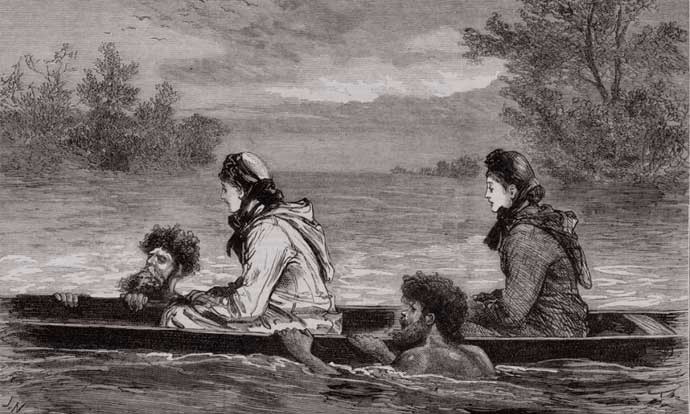
Transportation during early settlement in 1883. Source:: Culture Victoria
Trading destruction for slavery
A considerable portion of the males of a tribe having been shot down, the Black learns the uselessness of his resistance and sues for peace. When the White man is of opinion that the tribe has been so weakened and subdued that his small party has no longer anything to fear if moderate precautions are taken, peace is granted, and the tribe is allowed to "come in," as it is termed; that is, to make its home at some appointed place at or near the establishment of the station holder.
From this epoch, a few of the men of the tribe receive occasional employment on the station, for which they are paid in food. The refuse of animal slaughtered for station use is also generally given over to the tribe. Food is also received by the Blacks from some of the men in payment for the prostitution of their wives and daughters.
The consequences which follow are that the venereal diseases are invariably introduced and disseminated through the tribe, and that many die from them. Another outcome of this state of chronic debauchery is that infanticide, from being exceptional, becomes the rule.
Besides this, experience has shown that of the few children allowed to live, the majority die between the ages of fifteen and twenty of consumption the result probably of venereal in their parents when this stage has been reached, the Colonial Governments have stepped in several cases, collected the remnants of some or all of the tribes, and located them on what in Victoria arc called Aboriginal Reserves.
These, of which there are six in Victoria averaging between three and four thousand acres each, are placed usually under the care of Missionaries, the Blacks on them being fed, housed, and the young ones educated, at the cost principally of the Treasury.
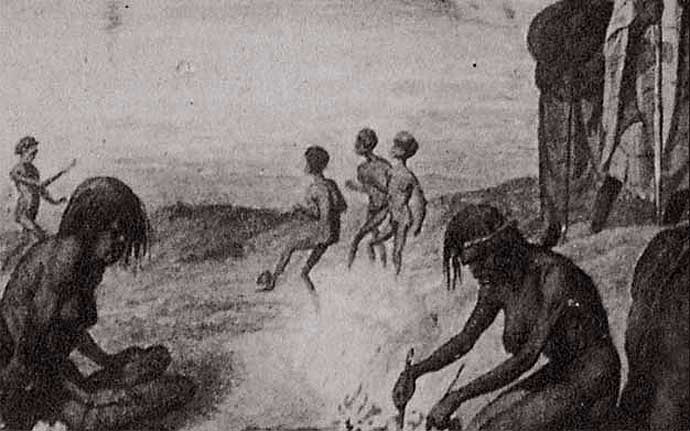
Detail of a sketch by William Blandowski (1822–1878) who was based in Melbourne c1840-60
Young people playing what is believed to be Marngrook, now known as AFL Football.
Christian Missions
Of the results obtained on these reserves I can speak from experience, having frequently visited them, and been for several years a member of the board entrusted with their supervision.
The Missionaries, for the most part are Movarians from Germany, and some of them members of the Church of England. On some of the reserves the teachers are officers of the public Education Department.
After a prolonged and peaceful inquiry into the state of the Blacks located on these establishments, I have come to the following conclusions, which I think the records of the Aboriginal Board of Victoria substantiate.
The children learn reading, writing, and arithmetic more easily than White children understand English pretty well, but speak it indifferently; for the Missionaries who teach them arc generally Germans, who themselves speak English badly. The Blacks on these reserves have easily been induced to give up murder, cannibalism (to which they were never much addicted), and polygamy. As regards religion and morality, passing over a little untoward show, it seems to me that they do not exist amongst them; and though these Blacks have been amongst us for forty years, and many of them were born and brought up on our Missionary stations.
I am convinced that, were they once more returned to their forests and cut off from communication with the Whites, they would in a single lifetime become again exactly what we originally found them.
In Western Australia and in the Northern Territory of South Australia there are two Roman Catholic missions to the Blacks, besides two or three Protestant Missions in South Australia, but I cannot speak from personal experience of the results which any of them have brought about.
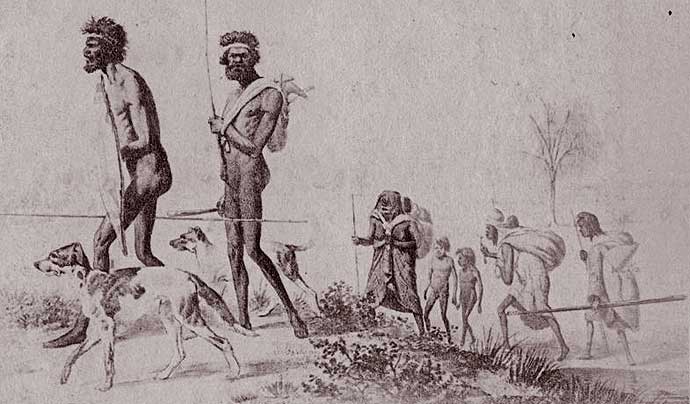
Sketch by William Blandowski (1822–1878) who was based in Melbourne c1840-60
Coloniser declares Native submission
As regards the Blacks, I should sum up the outcome of their contact with ourselves in this way. The only success which our treatment of them has had is in the cultivation of their intellects; and if their education is persevered with for several generations, I see no reason to prevent their being brought in this particular to a level with ourselves.
In bodily health they have conspicuously receded. Their state of dependence on us has undermined their former self-reliance, and left them without character.
Religion and civilization our Blacks have not attained. The White race seems destined, not to absorb, but to exterminate the Black of Australia.
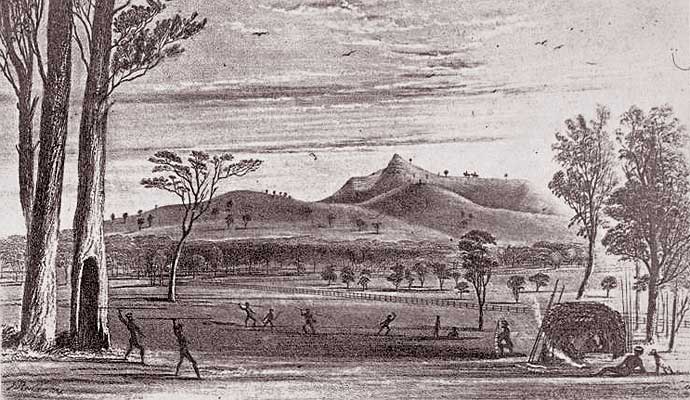
Spear throwing competition
Sketch by William Blandowski (1822–1878) who was based in Melbourne c1840-60

